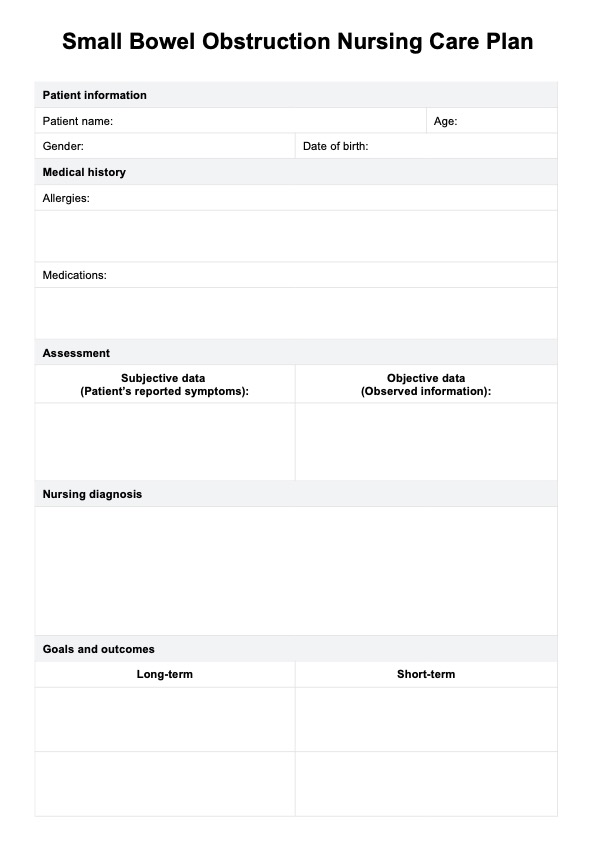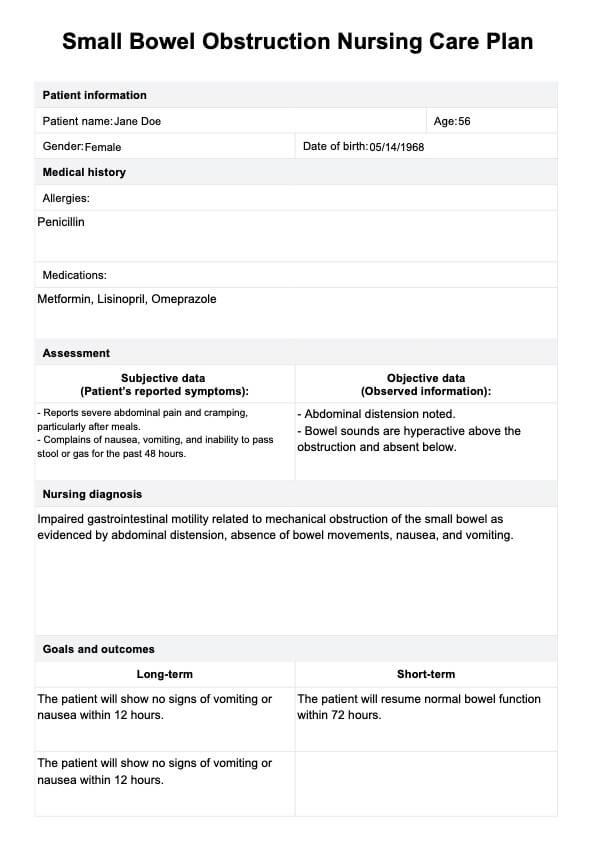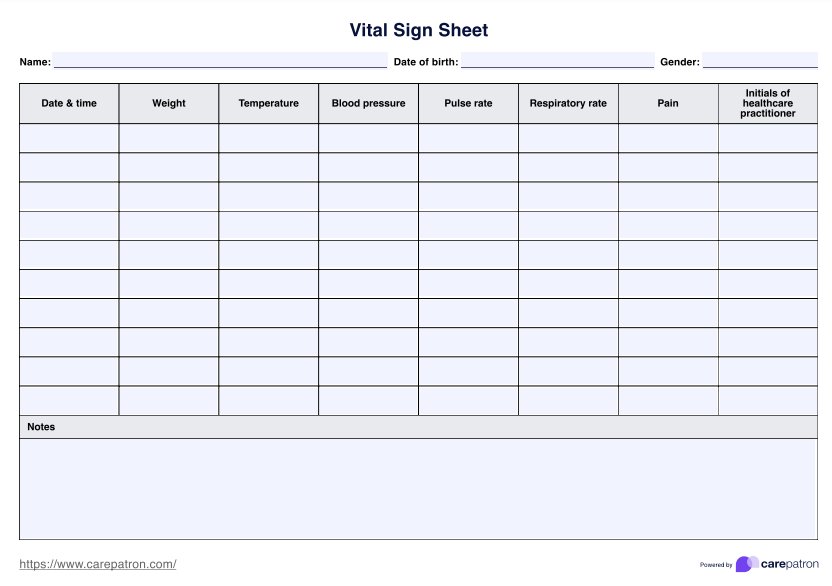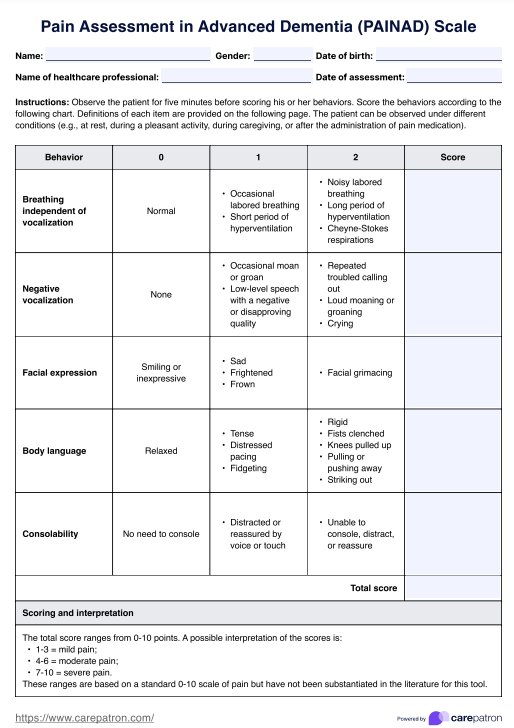Small Bowel Obstruction Nursing Care Plan
Utilize this comprehensive guide and nursing plan template to create effective care plans and confidently deliver superior small bowel obstruction treatment.


What is small bowel obstruction?
A small bowel obstruction is a blockage in the small intestine that prevents the normal passage of digestive contents. This obstruction can be partial or complete, hindering the movement of food, fluids, and gas through the intestines. Common causes include:
- Adhesions: Scar tissue from previous surgeries or infections that can constrict the intestine.
- Hernias: Portions of the intestine push through weakened areas in the abdominal wall.
- Tumors: Abnormal growths that obstruct the bowel.
- Inflammatory conditions: Diseases like Crohn's disease that cause swelling and narrowing of the intestine.
Symptoms of a small bowel obstruction include:
- Abdominal pain and cramping
- Bloating and distension
- Nausea and vomiting
- Inability to pass gas or stool
Treatment typically involves hospitalization, the approach of which depends on the severity of the obstruction. Non-surgical methods include nasogastric tube insertion to relieve pressure, IV fluids, and bowel rest. Surgery may be required if there is a complete blockage or if complications like strangulation or bowel perforation occur. Prompt medical attention is crucial to prevent serious complications.
What are the complications of a small bowel obstruction?
Complications of a small bowel obstruction can be serious and may include:
- Bowel strangulation: A portion of the intestine loses blood supply, which can lead to tissue death (necrosis). This is a medical emergency and requires immediate surgery.
- Perforation: The bowel wall may rupture due to pressure buildup, leading to a hole in the intestine. This can cause intestinal contents to leak into the abdominal cavity, resulting in peritonitis (a severe infection of the abdominal lining).
- Infection: A severe infection can occur if the obstruction causes perforation or tissue death, spreading bacteria into the bloodstream.
- Electrolyte imbalance: Vomiting and inability to absorb fluids can lead to dehydration and imbalances in electrolytes, affecting overall health and organ function.
- Aspiration: Vomiting associated with an obstruction can lead to aspiration, where stomach contents are inhaled into the lungs, causing respiratory complications.
- Prolonged obstruction: If the obstruction persists, it can lead to chronic pain, malnutrition, and weight loss due to inadequate nutrient absorption.
Small Bowel Obstruction Nursing Care Plan Template
Small Bowel Obstruction Nursing Care Plan Example
What is a Small Bowel Obstruction Nursing Care Plan Template?
A nursing care plan template for small bowel obstruction is crucial for managing patients with partial or complete blockage in the gastrointestinal tract. This condition often results from factors like adhesions from previous abdominal surgery, hernias, tumors, or inflammatory bowel disease. Key symptoms include severe abdominal pain, abdominal distension, altered bowel sounds, and changes in the normal flow of bowel movements, which may necessitate immediate surgical intervention.
A structured nursing diagnosis for small bowel obstruction ensures nurses can promptly identify critical signs such as fluid and electrolyte imbalances and altered bowel motility. This approach aids in effective nursing assessment and intervention, such as monitoring vital signs, managing abdominal distention, and addressing fluid and electrolyte imbalances to prevent complications.
A comprehensive nursing care plan supports the delivery of timely interventions, whether the intestinal obstruction is partial or complete, and guides postoperative care. This includes monitoring bowel sounds, managing severe abdominal pain, and ensuring regular evaluation through abdominal examinations. Utilizing a template streamlines crafting individualized care plans, enhancing patient outcomes, and reducing the risks associated with small bowel obstructions.
How does it work?
Follow these steps to use our Small Bowel Obstruction Nursing Care Plan effectively:
Step 1: Access the template
Begin by accessing the nursing care plan template for small bowel obstruction. Click "Use template" to open it in the Carepatron app where you can customize it, or you can save the PDF to your device by clicking "Download."
Step 2: Review the assessment section
After downloading, start by reviewing the assessment section of the template. Enter the subjective data collected from the patient, including their reported symptoms, such as abdominal pain and nausea, as well as any relevant medical history, like previous surgeries. Next, input the objective data from physical examinations and diagnostic tests, such as observed abdominal distension, altered bowel movement, sounds, and vital signs.
Step 3: Identify nursing diagnoses
Using the assessment data, identify appropriate nursing diagnoses for the patient. Common diagnoses for a small bowel obstruction might include acute pain related to the obstruction, risk factors for electrolyte imbalances due to fluid loss, and impaired gastrointestinal motility. Enter these diagnoses into the designated section of the template to guide subsequent care.
Step 4: Set goals and outcomes
Define specific goals and outcomes in the template to outline the expected results of the nursing care. Establish short-term goals for immediate relief, such as reducing pain and restoring fluid balance. Set long-term goals focusing on the patient’s overall recovery, normalization of bowel function, and education on preventing future obstructions.
Step 5: Implement interventions and evaluate
Proceed by filling in the nursing interventions section with planned actions to address each diagnosis, such as monitoring vital signs, administering IV fluids, and managing an NG tube. Regularly evaluate the patient’s progress by reviewing the effectiveness of these interventions, assessing outcomes, and making any necessary adjustments to the care plan to ensure optimal patient care.
When would you use this template?
An SBO nursing care plan is employed when a patient presents with signs and symptoms suggesting a partial or complete blockage in the small intestine. Nurses may utilize this more comprehensive nursing care plan in various situations, including:
Emergency department admissions
Patients arriving with abdominal pain, distension, vomiting, and constipation may indicate a possible SBO. Nurses in the emergency department initiate assessments, pain management, and interventions while preparing for further diagnostic tests.
Inpatient hospital care
Patients diagnosed with or suspected of having an SBO require comprehensive nursing care. Nurses monitor the patient's vital signs, assess abdominal symptoms, manage pain, and provide support before and after interventions like nasogastric tube insertion or surgery.
Postoperative care
Patients recovering from abdominal surgery, particularly those involving the intestines, are at risk of developing an SBO. Nurses monitor for signs of obstruction and provide postoperative care, including pain management, wound care, and monitoring bowel function.
Patients with a history of abdominal adhesions or hernias
Individuals with a history of abdominal surgeries, adhesions, or hernias are at higher risk for SBO. Nurses provide ongoing monitoring and educate these patients about signs and symptoms to report promptly.
Telemetry or step-down units
Patients recovering from an SBO or undergoing conservative management might be placed in telemetry or step-down units. Nurses continue to monitor their condition, manage pain, assess for complications, and provide support during recovery.
Patient education and discharge planning
Nurses are vital in educating patients and their families about SBO symptoms, dietary modifications, follow-up care, and when to seek medical attention after discharge.
Benefits of using this template
Using the small bowel obstruction nursing care plan template offers numerous advantages for practitioners in managing this complex condition:
- Enhanced nursing assessment and diagnosis: The template provides a structured framework for conducting a thorough abdominal examination and physical examination. This systematic approach ensures comprehensive nursing assessments, leading to accurate diagnoses of issues such as electrolyte imbalances and bowel motility disruptions.
- Streamlined identification of key issues: By clearly outlining signs and symptoms such as nausea and vomiting and abdominal pressure, the template helps practitioners quickly identify critical problems related to complete blockage and other obstructions in the gastrointestinal tract.
- Focused nursing interventions: The template guides practitioners in implementing effective nursing interventions. It includes actions to address issues such as electrolyte imbalances, bowel wall complications, and managing abdominal distension, ensuring that essential care components are discussed systematically.
- Clear goal setting and outcome measurement: Practitioners can set specific, measurable goals for managing bowel habits and restoring normal bowel function. This clarity aids in tracking patient progress and ensures that interventions are aligned with desired outcomes.
- Improved patient and family education: The template includes sections documenting patient and family education, helping ensure that patients and their families are informed about managing the condition, recognizing signs and symptoms, and understanding preventive measures.
Commonly asked questions
In an acute care surgery setting, treatment focuses on reducing abdominal pressure and relieving the obstruction. This often involves administering intravenous fluids and electrolyte replacement to manage fluid balance. Surgical intervention may be necessary to address the small intestinal obstruction directly.
Effective pain management for small bowel obstruction involves assessing the pain scale to determine severity and providing appropriate analgesics. In some cases, managing pain in adhesive small bowel obstruction may also require addressing the underlying cause of the obstruction to reduce abdominal pressure and discomfort.
Preventing complications involves early detection and treatment. Key practices include administering intravenous fluids to prevent dehydration, electrolyte replacement to balance vital nutrients, and using medications or interventions to relieve constipation and reduce symptoms. Regular monitoring and effective pain management are also crucial.














































































































